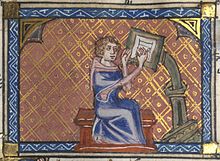Roman de la Rose
The first part of the poem's story is set in a walled garden, an example of a locus amoenus, a traditional literary topos in epic poetry and chivalric romance.Forty-five years later, circa 1275, in the second stage of composition, Jean de Meun or Jehan Clopinel wrote 17,724 additional lines, in which he expanded the roles of his predecessor's allegorical personages, such as Reason and Friend, and added new ones, such as Nature and Genius.[2] Its emphasis on sensual language and imagery, along with its supposed promulgation of misogyny, provoked attacks by Jean Gerson, Christine de Pizan, Pierre d'Ailly, and many other writers and moralists of the 14th and 15th centuries.The historian Johan Huizinga has written: "It is astonishing that the Church, which so rigorously repressed the slightest deviations from dogma of a speculative character, suffered the teaching of this breviary of the aristocracy (for the Roman de la Rose was nothing else) to be disseminated with impunity.In 1900, the pre-Raphaelite F. S. Ellis translated the whole of the poem into English verse, with the exception of a section describing a sexual encounter, which he included in an appendix in Old French with the note that he "believes that those who will read them will allow that he is justified in leaving them in the obscurity of the original".


Guillaume de DoleGuillaume de LorrisJean de MeunOld FrenchWikisourceallegoricaldream visionromantic lovefemale sexualitymetonymslove affairwalled gardenlocus amoenusliterary toposepic poetrychivalric romanceJean GersonChristine de PizanPierre d'AillyJohan HuizingabreviaryencyclopedicGaston ParisC. S. LewisMikhail BakhtinBurgundianBritish LibraryMaster of the Prayer Books of around 1500Engelbert II of NassauincunabulaGenevawoodcutsRoman de la Rose Digital LibraryMiddle EnglishThe Romaunt of the RoseChaucerMiddle DutchsonnetsF. S. EllisThe Allegory of LoveKate SoperAbélardHéloïseBodleian LibraryArs AmatoriaJeanne MontbastonIncunabula Short Title CatalogueLibrary of CongressProject GutenbergEncyclopædia Britannica